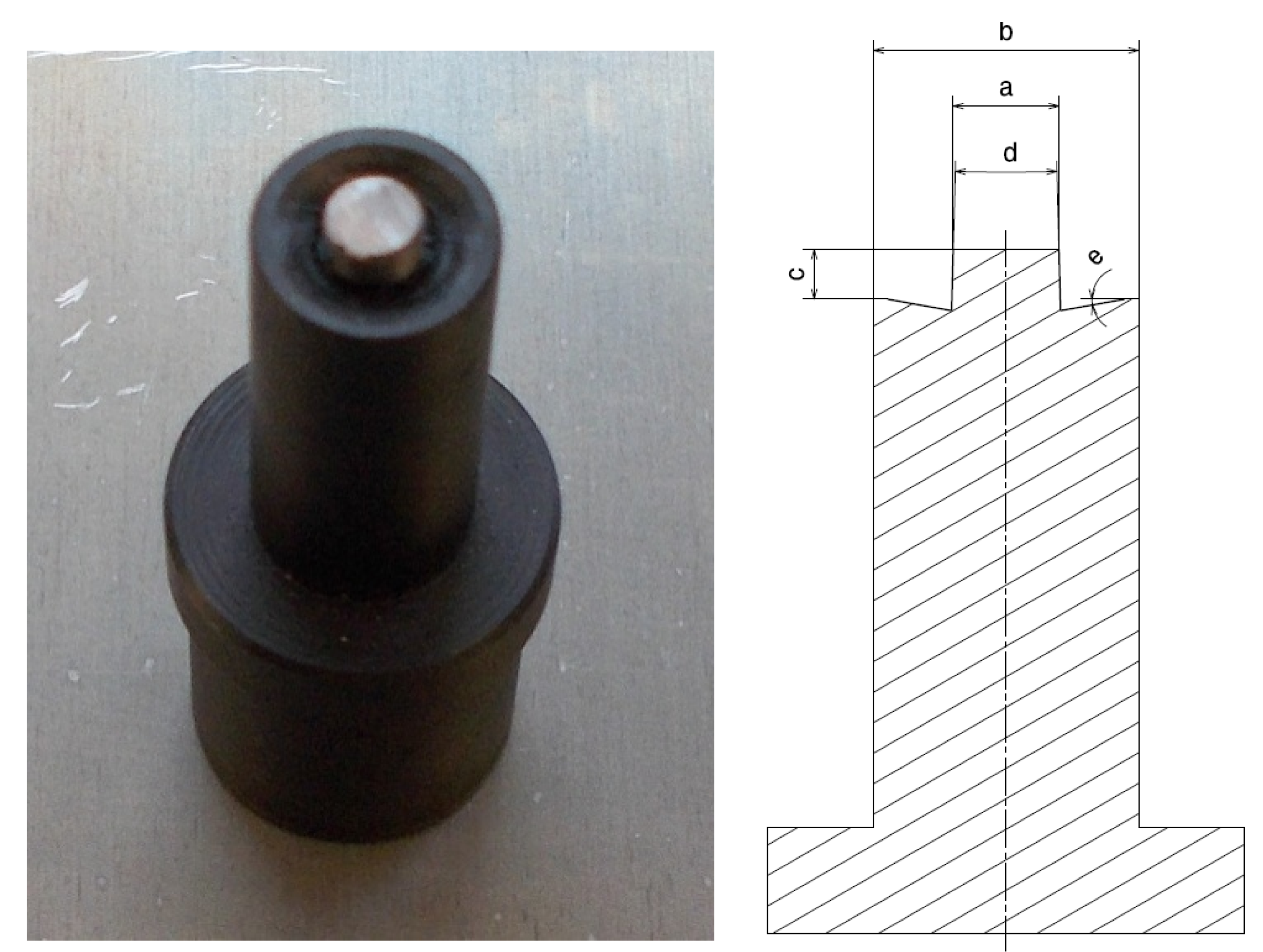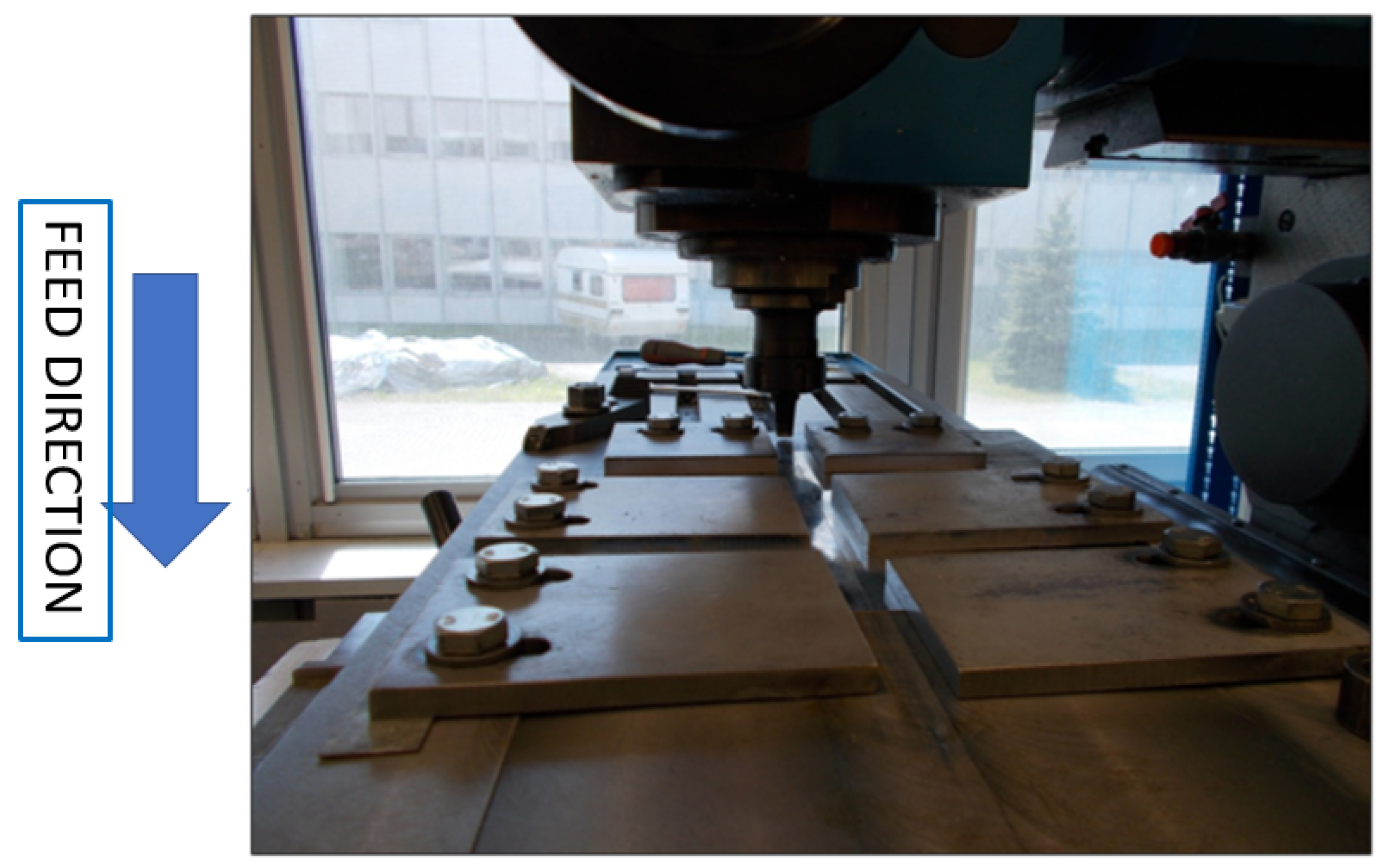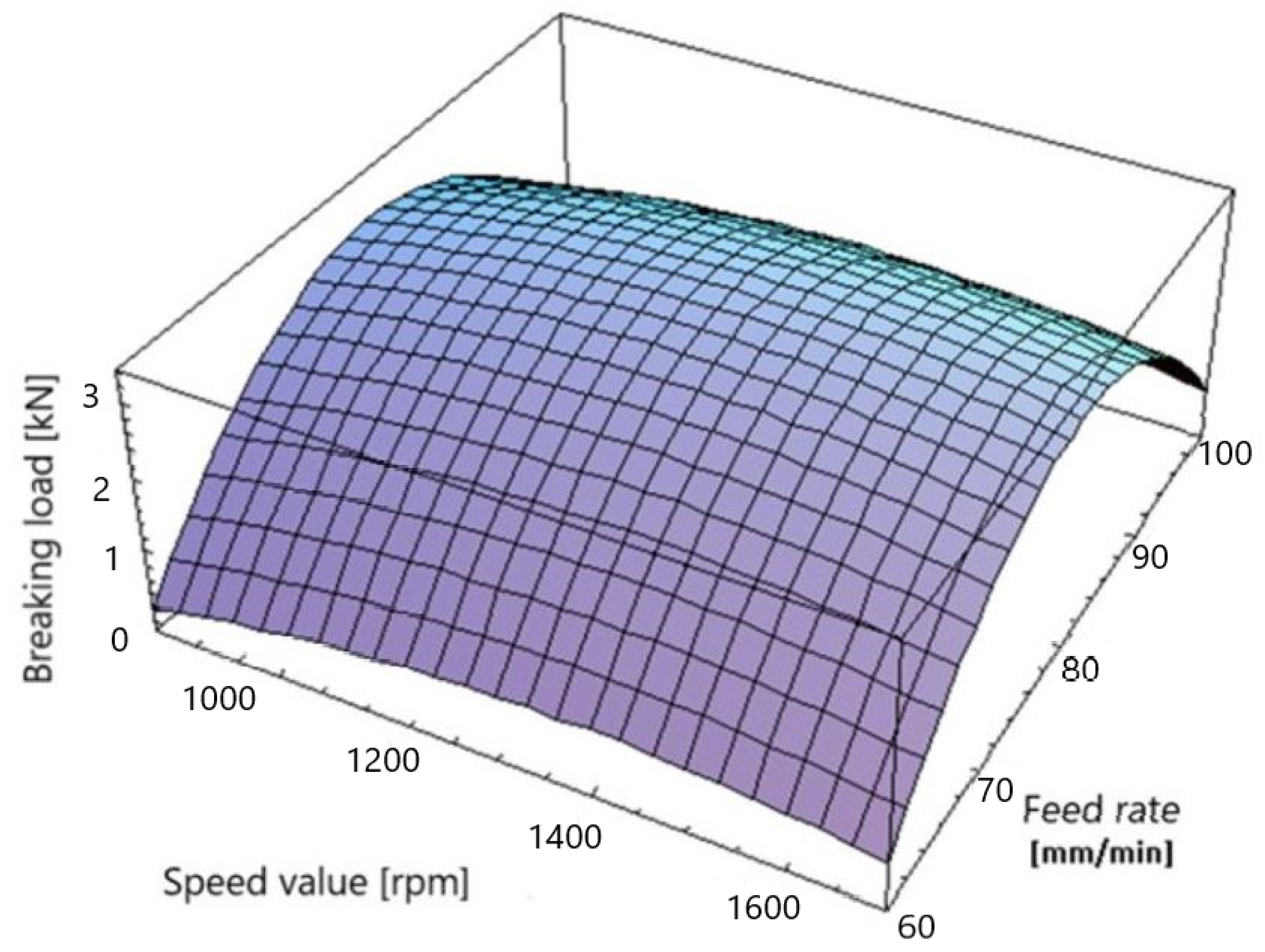Advanced Analytical Methods of the Analysis of Friction Stir Welding Process (FSW) of Aluminum Sheets Used in the Automotive Industry
Abstract
:1. Introduction
2. Materials and Methods
- -
- Selection of the materials, tools, and machinery needed to carry out the test:
- -
- Selection of process parameters to obtain high tensile strength (feed and spindle speed; see Table 1).
- -
- Conducting laboratory tests using the testing machine:
- -
- Initial tension force 5 N,
- -
- Crosshead speed 12 mm/min.
- -
- Analysis of the test results obtained and conducting a statistical study using the Hartley method. The three-level plan allows for a number of experiments equal to the combination of input factors at all levels of variation, which can be written as 3n. A disadvantage of this test plan is that the number of experiments required increases rapidly as the number of input factors increases. For this reason, the three-level plans used in practice usually do not exceed the number of input factors, n = 3.
- -
- Calculation of the average electricity consumption consumed in the material welding process;
- -
- Analysis of the impact of electricity consumption.
3. Results and Discussion
4. Statistical Test for the Hartley Plan FSW Method
- -
- Calculating the G-factor on the basis of the experiments carried out:
- -
- Calculation of degrees of freedom:
- -
- The value of the Gkr coefficient was selected from the tables based on the calculated degrees of freedom:
5. Calculation of Regression Coefficients Based on Table 8 and Table 9
- -
- Calculation of measurement error variances:
- -
- Calculation of the number of degrees of freedom:
- -
- Determination of the critical value of the tkr coefficient on the basis of tabulated data:
- -
- Determination of the coefficient value b0kr:
- -
- Calculation of the adequacy variance:
- -
- Determining the number of degrees of freedom of the numerator:
- -
- Determining the number of degrees of freedom of the denominator:
- -
- Definition of value Fkr:
- -
- Determination of the empirical value, F:
6. Conclusions
Author Contributions
Funding
Institutional Review Board Statement
Informed Consent Statement
Data Availability Statement
Conflicts of Interest
References
- Jacquin, D.; Guillemot, G. A review of microstructural changes occurring during FSW in aluminum alloys and their modeling. J. Mat. Proc. Tech. 2020, 288, 116706. [Google Scholar] [CrossRef]
- Kumar, K.; Kailas, S.V. The role of friction stir welding tool on material flow and weld formation. Mat. Scien. Eng. A 2008, 485, 367–374. [Google Scholar] [CrossRef] [Green Version]
- Abidi, M.H.; Ali, N.; Ibrahimi, H.; Anjum, S.; Bajaj, D.; Siddiquee, A.N.; Alkahtani, M.; Rehman, A.U. T-FSW of Dissimilar Aerospace Grade Aluminium Alloys: Influence of Second Pass on Weld Defects. Metals 2020, 10, 525. [Google Scholar] [CrossRef] [Green Version]
- Wang, X.; Wang, K.; Shen, Y.; Hu, K. Comparison of fatigue property between friction stir and TIG welds. J. Univ. Sci. Technol. Beijing Miner. Metall. Mater. 2008, 15, 280–284. [Google Scholar] [CrossRef]
- Terra, C.S.; Luis, J.; Silveira, L. Models for FSW forces using a square pin profile tool. J. Manuf. Proc. 2021, 68, 1395–1404. [Google Scholar] [CrossRef]
- Huang, X.; Scheuring, J.; Reynolds, A.P. FSW of High Strength 7XXX Aluminum Using Four Process Variants. In Friction Stir Welding and Processing VIII; Mishra, R.S., Mahoney, M.W., Sato, Y., Hovanski, Y., Eds.; Springer: Cham, Switzerland, 2015; pp. 291–298. [Google Scholar] [CrossRef]
- Abdullah, J.A.; MRohim, M.N.; Mohammed, M.M.; Derazkola, H.A. Effects of Partial-Contact Tool Tilt Angle on Friction Stir Welded AA1050 Aluminum Joint Properties. Materials 2023, 16, 4091. [Google Scholar] [CrossRef]
- Essa, A.R.S.; Ahmed, M.M.Z.; Aboud, A.R.K.; Alyamani, R.; Sebaey, T.A. Prediction of Tool Eccentricity Effects on the Mechanical Properties of Friction Stir Welded AA5754-H24 Aluminum Alloy Using ANN Model. Materials 2023, 16, 3777. [Google Scholar] [CrossRef]
- Kayode, O.; Akinlabi, E.T. An overview on joining of aluminium and magnesium alloys using friction stir welding (FSW) for automotive lightweight applications. Mater. Res. Express 2019, 6, 112005. [Google Scholar] [CrossRef]
- Yuvaraj, K.P.; AshokaVarthanan, P.; Haribabu, L.; Madhubalan, R.; Boopathiraja, K.P. Optimization of FSW toolparameters for joining dissimilar AA7075-T651 and AA6061 aluminium alloys using Taguchi Technique. Mater. Today Proc. 2021, 45, 919–925. [Google Scholar] [CrossRef]
- Rambabu, G.; Balaji Naik, D.; Venkata Rao, C.H.; Srinivasa Rao, K.; Madhusudan Reddy, G. Optimization of friction stir welding parameters for improved corrosion resistance of AA2219 aluminum alloy joints. Def. Technol. 2015, 11, 330–337. [Google Scholar] [CrossRef] [Green Version]
- Hassan, A.; Pedapati, S.R.; Awang, M.; Soomro, I.A. A Comprehensive Review of Friction Stir Additive Manufacturing (FSAM) of Non-Ferrous Alloys. Materials 2023, 16, 2723. [Google Scholar] [CrossRef]
- Feier, A.; Both, I.; Petzek, E. Optimisation of the Heterogeneous Joining Process of AlMg3 and X2CrNiMo17-12-2 Alloy by FSW Method. Materials 2023, 16, 2750. [Google Scholar] [CrossRef]
- Fratini, L.; Zuccarello, B. An analysis of through-thickness residual stresses in aluminum FSW butt joints. Inter. J. Mach. Tool Manuf. 2006, 46, 611–619. [Google Scholar] [CrossRef]
- Threadgill, P.L.; Leonard, A.J.; Shercliff, H.R.; Withers, P.J. Friction stir welding of aluminum alloys. Int. Mater. Rev. 2009, 54, 49–93. [Google Scholar] [CrossRef]
- Shigematsu, I.; Kwon, Y.J.; Suzuki, K.; Imai, T.; Saito, N. Joining of 5083 and 6061 aluminum alloys by friction stir welding. J. Mater. Sci. Lett. 2003, 22, 343–356. [Google Scholar] [CrossRef]
- Vilaca, P.; Thomas, W. Friction Stir Welding Technology. In Structural Connections for Lightweight Metallic Structures; Springer: Berlin/Heidelberg, Germany, 2011; pp. 85–124. [Google Scholar] [CrossRef]
- Dialami, N.; Chiumenti, M.; Cervera, M.; Segatori, A.; Osikowicz, W. Enhanced friction model for Friction Stir Welding (FSW) analysis: Simulation and experimental validation. Int. J. Mech. Sci. 2017, 133, 555–567. [Google Scholar] [CrossRef] [Green Version]
- Lee, W.B.; Yeon, Y.M.; Jung, S.B. The improvement of mechanical properties of friction stir welded A356 AL alloy. Mater. Sci. Eng. A 2003, 355, 154–159. [Google Scholar] [CrossRef]
- Bhardwaj, N.; Narayanan, R.G.; Dixit, U.S.; Hashmi, M.S.J. Recent development in friction stir welding and resulting industrial practices. Adv. Mater. Process. Technol. 2019, 5, 461–496. [Google Scholar] [CrossRef]
- Sharma, A.; Dwivedi, V.K. Effects due to tool design during FSW Process of Aluminium Alloy AA7075 T-6. Adv. Mater. Process. Technol. 2022, 8, 1510–1532. [Google Scholar] [CrossRef]
- Zifčák, P.; Blažíček, P.; Pastier, P. The effect of selected welding parameters on properties of FSW welded joints in ferritic steel type 2235 JRC+N. Weld. Technol. Rev. 2014, 86. [Google Scholar]
- Kossakowski, P.G.; Wciślik, W.; Bakalarz, M. Effect of selected Friction Stir Welding parameters on mechanical properties of joints. Arch. Civ. Eng. 2019, 65, 51–62. [Google Scholar] [CrossRef] [Green Version]
- Meng, X.; Huang, Y.; Cao, J.; Shen, J.; dos Santos, J.F. Recent progress on control strategies for inherent issues in friction stir welding. Prog. Mater. Sci. 2020, 115, 100706. [Google Scholar] [CrossRef]
- Su, H.; Wu, C.S.; Pittner, A.; Rethmeier, M. Thermal energy generation and distribution in friction stir welding of aluminum alloys. Energy 2014, 77, 720–731. [Google Scholar] [CrossRef]
- Magalhaes, V.M.; Leitao, C.; Rodrigues, D.M. Friction stir welding industrialization and research status. Sci. Technol. Weld. Join. 2017, 23, 400–409. [Google Scholar] [CrossRef]
- Derazkola, H.A.; Eyvazian, A.; Simchi, A. Modeling and experimental validation of material flow during FSW of polycarbonate. Mater. Today Commun. 2020, 22, 100796. [Google Scholar] [CrossRef]
- Khan, N.Z.; Bajaj, D.; Siddiquee, A.N.; Khan, Z.A.; Abidi, M.H.; Umer, U.; Alkhalefah, H. Investigation on Effect of Strain Rate and Heat Generation on Traverse Force in FSW of Dissimilar Aerospace Grade Aluminium Alloys. Materials 2019, 12, 1641. [Google Scholar] [CrossRef] [PubMed] [Green Version]
- Al-Sabur, R. Tensile strength prediction of aluminium alloys welded by FSW using response surface methodology—Comparative review. Mater. Today Proc. 2021, 45, 4504–4510. [Google Scholar] [CrossRef]
- Ahmmad, M.M.; Sumi, Y. Strength and Deformability of corroded steel plates under quasi-static tensile load. J. Mar. Sci. Technol. 2010, 15, 1–15. [Google Scholar] [CrossRef]
- Gagliardi, F.; Palaia, D.; Ambrogio, G. Enery consumption and CO2 emmisions of joining process for manufacturing hybrid structures. J. Clean. Prod. 2019, 228, 425–436. [Google Scholar] [CrossRef]
- Sheng, X.; Li, K.; Wu, W.; Yang, Y.; Liu, Y.; Zhao, Y.; He, G. Microstructure and Mechanical Properties of Friction Stir Welded Joint of an Aluminum Alloy Sheet 6005A-T4. Metals 2019, 9, 1152. [Google Scholar] [CrossRef] [Green Version]
- Huda, Z.; Taib, N.I.; Zaharinie, T. Characterization of 2024 T3: An aerospace aluminum alloy. Mater. Chem. Phys. 2009, 113, 515–517. [Google Scholar] [CrossRef]
- Shrivastav, A.; Krones, M.; Pfefferkorn, F.E. Comparison of energy consumption and environmental impact of friction stir welding and gas metal arc welding for aluminum. CIRP J. Manuf. Sci. Technol. 2015, 9, 159–168. [Google Scholar] [CrossRef]
- Hanus, R.; Zych, M.; Mosorov, V.; Golijanek-Jędrzejczyk, A.; Jaszczur, M.; Andruszkiewicz, A. Evaluation of liquid-gas flow in pipeline using gamma-ray absorption technique and adwanced signal processing. Metrol. Meas. Syst. 2018, 28, 145–159. [Google Scholar] [CrossRef]
- Brundage, M.P.; Bernstein, W.Z.; Hoffenson, S.; Chang, Q.; Nishi, H.; Kliks, T.; Morris, K.C. Analyzing environmental sustainability methods for use earlier in the product lifecycle. J. Clean. Prod. 2018, 187, 877–892. [Google Scholar] [CrossRef] [PubMed]
- Khalid, M.B.; Beithou, N.; Al-Taani MASh Andruszkiewicz, A.; Alahmer, A.; Borowski, G.; Alsaqoor, S. Integrated Eco-Friendly Outdoor Cooling System—Case Study of Hot-Humid Climate Countries. J. Ecol. Eng. 2022, 23, 64–72. [Google Scholar] [CrossRef]
- Broniszewski, M.; Werle, S. CO2 reduction methods and evaluation of proposed energy efficiency improvements in Poland’s large industrial plant. Energy 2022, 202, 117704. [Google Scholar] [CrossRef]
- Li, Y.; Feng, Y.; Zhang, X.; Wu, C.S. Energy propagation in plasma arc welding with keyhole tracking. Energy 2014, 64, 1044–1056. [Google Scholar] [CrossRef]
- Ciuła, J.; Generowicz, A.; Gaska, K.; Gronba-Chyła, A. Efficiency Analysis of the Generation of Energy in a Biogas CHP System and its Management in a Waste Landfill–Case Study. J. Ecol. Eng. 2022, 23, 143–156. [Google Scholar] [CrossRef]
- Tang, Y.; Mak, K.; Zhao, Y.F. A framework to reduce product environmental impact through design optimization for additive manufacturing. J. Clean. Prod. 2016, 137, 1560–1572. [Google Scholar] [CrossRef]
- Gronba-Chyła, A.; Generowicz, A.; Kramek, A. Using Selected Types of Waste to Produce New Light Ceramic Material. Pol. J. Environ. Stud. 2021, 30, 2073–2083. [Google Scholar] [CrossRef]
- Gronba-Chyła, A.; Generowicz, A.; Kwaśnicki, P.; Cycoń, D.; Kwaśny, J.; Grąz, K.; Gąska, K.; Ciuła, J. Determining the Effectiveness of Street Cleaning with the Use of Decision Analysis and Research on the Reduction in Chloride in Waste. Energies 2022, 15, 3538. [Google Scholar] [CrossRef]
- Ingarao, G. Manufacturing strategies for efficiency in energy and resources use: The role of metal shaping processes. J. Clean. Prod. 2017, 142, 2872–2886. [Google Scholar] [CrossRef]
- Wang, L.; Shao, J. Digital economy, entrepreneurship and energy efficiency. Energy 2023, 269, 126801. [Google Scholar] [CrossRef]
- Kowalski, S.; Opoka, K.; Ciuła, J. Analysis of the end-of-life the front suspension beam of a vehicle. Eksploat. Niezawodn. Maint. Reliab. 2022, 24, 446–454. [Google Scholar] [CrossRef]
- Korzyński, M. Experiment Methodology; WNT: Warszawa, Poland, 2013. (In Polish) [Google Scholar]






| Rotation Speed (rpm) | Feed Rate (mm/min) |
|---|---|
| 900 | 60 |
| 80 | |
| 100 | |
| 1300 | 60 |
| 80 | |
| 100 | |
| 1700 | 60 |
| 80 | |
| 100 |
| Condition | Tensile Strength (MPa) | Yield Stress (MPa) | Extension (%) | HBW (HB) |
|---|---|---|---|---|
| Pressing | 490 | 380 | 8 | 130 |
| Pulling | 520 | 420 | 10 | 140 |
| Alu/Stop 2024 | Mg (%) 1.20–1.80 | Mn (%) 0.30–0.90 | Fe (%) ≤0.50 | Si (%) ≤0.50 | Si+Fe (%) - | Cu (%) 3.80–4.90 | Zn (%) ≤0.25 | Cr (%) ≤0.10 | Mn+Cr (%) - |
|---|---|---|---|---|---|---|---|---|---|
| Ti (%) ≤0.15 | Bi (%) - | Ni (%) - | Pb (%) | Sn (%) - | Zr (%) - | Zr+Ti (%) ≤0.20 | Others (%) ≤0.05 | Total others (%) ≤0.15 | Al rest |
| Rotational Speed (RPM) | Feed Rate (mm/min) | F1 Breaking Force (kN) | F2 Breaking Force (kN) | |
|---|---|---|---|---|
| Joining method, FSW | 900 | 60 | 3.62 | 3.74 |
| 80 | 3.80 | 3.90 | ||
| 100 | 4.10 | 4.09 | ||
| 1300 | 60 | 3.45 | 3.60 | |
| 80 | 3.40 | 3.19 | ||
| 100 | 3.15 | 3.17 | ||
| 1700 | 60 | 3.57 | 3.32 | |
| 80 | 3.70 | 3.78 | ||
| 100 | 3.62 | 3.75 |
| Rotational Speed (RPM) | Feed Rate (mm/min) | F1 (kN) | F2 (kN) |
|---|---|---|---|
| 900 | 60 | 3.62 | 3.74 |
| 80 | 3.80 | 3.90 | |
| 100 | 4.10 | 4.09 | |
| 1300 | 60 | 3.45 | 3.60 |
| 80 | 3.40 | 3.19 | |
| 100 | 3.15 | 3.17 | |
| 1700 | 60 | 3.57 | 3.32 |
| 80 | 3.70 | 3.78 | |
| 100 | 3.62 | 3.75 |
| No. | Rotational Speed (RPM) | Feed Rate p (mm/min) |
|---|---|---|
| 1. | 1700 | 100 |
| 2. | 1700 | 80 |
| 3. | 1700 | 60 |
| 4. | 1300 | 100 |
| 5. | 1300 | 80 |
| 6. | 1300 | 60 |
| 7. | 900 | 100 |
| 8. | 900 | 80 |
| 9. | 900 | 60 |
| No. | F1 (kN) | F2 (kN) | F Average (kN) |
|---|---|---|---|
| C1. | 3.62 | 3.75 | 3.69 |
| 2. | 3.70 | 3.78 | 3.74 |
| 3. | 3.57 | 3.32 | 3.45 |
| 4. | 3.15 | 3.17 | 3.16 |
| 5. | 3.40 | 3.19 | 3.295 |
| 6. | 3.45 | 3.60 | 3.5 |
| 7. | 4.10 | 4.09 | 4.1 |
| 8. | 3.80 | 3.90 | 3.85 |
| 9. | 3.62 | 3.74 | 3.68 |
| No. | x1 | x2 | x1x2 | ȳ | ||
|---|---|---|---|---|---|---|
| 1. | + | + | + | 3.69 | ||
| 2. | + | 0 | 0 | 3.74 | ||
| 3. | + | − | − | 3.45 | ||
| 4. | 0 | + | 0 | 3.16 | ||
| 5. | 0 | 0 | 0 | 3.295 | ||
| 6. | 0 | − | 0 | 3.5 | ||
| 7. | − | + | + | 4.1 | ||
| 8. | − | 0 | 0 | 3.85 | ||
| 9. | − | − | + | 3.68 | ||
| Ʃ | −0.75 | 0.34 | 8.02 | − |
| No. | y1 | y2 | ȳi | S2 (yi) | Ўi | (ȳi − Ўi)2 |
|---|---|---|---|---|---|---|
| 1. | 3.62 | 3.74 | 3.69 | 0.0036 | 3.4578 | 0.0540 |
| 2. | 3.80 | 3.90 | 3.74 | 0.0025 | 3.2278 | 0.2623 |
| 3. | 4.10 | 4.09 | 3.45 | 0.000025 | 3.5695 | 0.0142 |
| 4. | 3.45 | 3.60 | 3.16 | 0.005625 | 3.6789 | 0.2692 |
| 5. | 3.40 | 3.19 | 3.295 | 0.011025 | 3.1267 | 0.1683 |
| 6. | 3.15 | 3.17 | 3.5 | 0.0001 | 3.8976 | 0.1580 |
| 7. | 3.57 | 3.32 | 4.1 | 0.015625 | 3.5689 | 0.2820 |
| 8. | 3.70 | 3.78 | 3.85 | 0.0016 | 3.8798 | 0.0008 |
| 9. | 3.62 | 3.75 | 3.68 | 0.004225 | 3.1674 | 0.2627 |
| Rotational Speed (RPM) | Feed Rate (mm/min) | F1 (kN) | F2 (kN) |
|---|---|---|---|
| 900 | 100 | 4.10 | 4.09 |
Disclaimer/Publisher’s Note: The statements, opinions and data contained in all publications are solely those of the individual author(s) and contributor(s) and not of MDPI and/or the editor(s). MDPI and/or the editor(s) disclaim responsibility for any injury to people or property resulting from any ideas, methods, instructions or products referred to in the content. |
© 2023 by the authors. Licensee MDPI, Basel, Switzerland. This article is an open access article distributed under the terms and conditions of the Creative Commons Attribution (CC BY) license (https://creativecommons.org/licenses/by/4.0/).
Share and Cite
Chyła, K.; Gaska, K.; Gronba-Chyła, A.; Generowicz, A.; Grąz, K.; Ciuła, J. Advanced Analytical Methods of the Analysis of Friction Stir Welding Process (FSW) of Aluminum Sheets Used in the Automotive Industry. Materials 2023, 16, 5116. https://doi.org/10.3390/ma16145116
Chyła K, Gaska K, Gronba-Chyła A, Generowicz A, Grąz K, Ciuła J. Advanced Analytical Methods of the Analysis of Friction Stir Welding Process (FSW) of Aluminum Sheets Used in the Automotive Industry. Materials. 2023; 16(14):5116. https://doi.org/10.3390/ma16145116
Chicago/Turabian StyleChyła, Krzysztof, Krzysztof Gaska, Anna Gronba-Chyła, Agnieszka Generowicz, Katarzyna Grąz, and Józef Ciuła. 2023. "Advanced Analytical Methods of the Analysis of Friction Stir Welding Process (FSW) of Aluminum Sheets Used in the Automotive Industry" Materials 16, no. 14: 5116. https://doi.org/10.3390/ma16145116
APA StyleChyła, K., Gaska, K., Gronba-Chyła, A., Generowicz, A., Grąz, K., & Ciuła, J. (2023). Advanced Analytical Methods of the Analysis of Friction Stir Welding Process (FSW) of Aluminum Sheets Used in the Automotive Industry. Materials, 16(14), 5116. https://doi.org/10.3390/ma16145116









